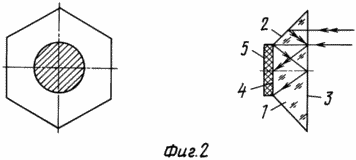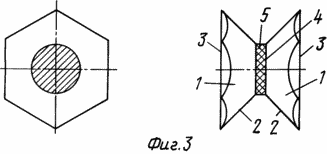| Start of section
Production, amateur Radio amateurs Aircraft model, rocket-model Useful, entertaining |
Stealth Master
Electronics Physics Technologies Inventions |
Secrets of the cosmos
Secrets of the Earth Secrets of the Ocean Tricks Map of section |
|
| Use of the site materials is allowed subject to the link (for websites - hyperlinks) | |||
Navigation: => |
Home / Patent catalog / Catalog section / Back / |
|
INVENTION
Patent of the Russian Federation RU2158045
![]()
SOLAR PHOTOELECTRIC MODULE WITH LUMBER ENERGY CONCENTRATOR
The name of the inventor: Strebkov DS (RU); Tver'yanovich EV (RU); Artemov AA (RU); Petar Rakin (YU)
The name of the patent holder: All-Russian Scientific Research Institute of Agriculture Electrification
Address for correspondence: 109456, Moscow, 1-st Veshnyakovskiy pr., 2, VIESH, ONTI and patents
Date of commencement of the patent: 1999.01.15
The invention relates to solar engineering, in particular solar photovoltaic modules with radiation concentrators for generating electricity. The technical result of the invention is to increase the specific power of the solar photoelectric module, to simplify the manufacturing technology of the optical element of the photoelectric module and to reduce its cost price. Essence: in a solar photovoltaic module with a radiant energy concentrator having an optically transparent element with an input and output facets and a photoconverter, the output face of the optical element is made in the form of a circle, and the input face is in the form of a hexagon. The photoelectric module can contain two identical optically transparent elements, and a photoconverter with two-sided sensitivity is installed on the output facets of optical elements directed in opposite directions.
DESCRIPTION OF THE INVENTION
The invention relates to solar engineering, in particular solar photovoltaic modules with a radiation concentrator for generating electricity.
There is a photoelectric module containing a solar energy concentrator made in the form of an optically transparent prism of total internal reflection, in the form of a truncated quadrangular pyramid (as USSR N1620784, MKI 6 F 24 J 2/08, BI N2, 1991).
The various rectangular bases serve as the edges of the entrance and exit of radiation. The photoconverter is installed in contact with the radiation output face, i.e. In contact with a smaller base. The ratio of the areas of the input and output faces of the prism containing the working surface and solar cells determines the theoretical coefficient of concentration of solar radiation on the working surface of the photoelectric module.
The disadvantage of this design solution is the need to cut round silicon plates, which leads to an increase in the cost of the module, and a low coefficient of concentration of solar radiation per unit area of the working surface of the photoconverter.
The closest in terms of technical nature to the proposed invention is a photoelectric module containing an optical element with a trapezoidal cross-section, the side faces of which are made reflecting solar radiation, and the various bases serve as input and output facets in the form of a truncated cone (USSR USSR N1048260, MKI 6 F 24 J 3/02, BI N38, 1983).
The disadvantage of this design solution is the low coefficient of use of the working surface in the formation of large solar cells from individual photovoltaic modules, therefore a significant part of the solar radiation entering the solar cell entrance surface does not reach the working surface of the photoconverters, which leads to a significant decrease in the output power of the photoelectric module , And consequently, the entire solar battery as a whole.
The object of the present invention is to increase the solar radiation concentration coefficient in a separate solar photovoltaic module, to reduce the cost of a solar battery consisting of such modules, due to a more rational use of the working surface area of each concentrator.
As a result of the use of the present invention, the specific power of the solar photovoltaic module is increased and its cost is reduced.
The above technical result is achieved by the fact that in the solar photovoltaic module with a concentrator of radiant energy containing an optically transparent element with an input and output edges and a photoconverter, the input face of the optical element is made in the form of a hexagon. When the input facet of the optical element of the solar photovoltaic module in the form of a hexagon is achieved, the most compact packing of optical elements is achieved when assembling solar photovoltaic modules in a single battery. At the same time, the loss of solar energy on interelement connections is completely excluded due to the absence of voids between individual photoelectric modules. This achieves the maximum possible concentration of solar radiation per unit surface of the photoconverter, hence, reducing the cost of the entire solar battery. In order to increase the concentration of solar radiation on the working surface, and to increase the average daily illumination of the working surface of the solar photoelectric module, a photoconverter with two-sided sensitivity is used. A photoconverter with two-sided sensitivity is installed on the circular output edges of two identical optical elements of solar photovoltaic modules directed in opposite directions.
The essence of the invention is illustrated in Fig. 1, Fig. 2, Fig. 3.
 |
 |
 | |
1 shows a general view of a solar photovoltaic module.
In Fig. 2 is a diagram of a solar photoelectric module with a concentrator of radiant energy with an image of the path of the rays in it.
In Fig. 3 shows a twin solar photoelectric module with a concentrator of radiant energy.
A solar photoelectric module with a radiant energy concentrator comprises an optically transparent element 1, a conical reflecting surface 2, an input facet 3 made in the form of a hexagon and an output face 4 on which the photoconverter 5 is mounted. Moreover, the input face 3 is made larger in relation to the output face 4 and is made in the form of a hexagon.
The solar photoelectric module with a radiant energy concentrator works as follows:
The solar radiation hits the hexagonal input face 3 of the concentrator, penetrates into the interior, reaching the conical reflecting surface 2 on which the reflective coating is applied, is reflected to the face 3 of the radiation input, after which it is reflected at the angle of total internal reflection to the face of the optical radiation output from the concentrator 4, where A photoconverter 5 is installed that converts the incident solar radiation into an electric current. In a dual photoelectric module with a radiant energy concentrator, a photoconverter 5 with two-sided sensitivity is mounted on the output faces of 4 two optically transparent elements directed in opposite directions. The dual solar photovoltaic module operates in a similar manner.
Angle ![]() Between the conical reflecting surface and the surface of the solar radiation input is selected from the following relationship:
Between the conical reflecting surface and the surface of the solar radiation input is selected from the following relationship: ![]() = 2 ·
= 2 · ![]() ,
,
Where ![]() - the angle of total internal reflection for the material of the concentrator.
- the angle of total internal reflection for the material of the concentrator.
Moreover, ![]() = Arcsin1 / n,
= Arcsin1 / n,
Where n is the refractive index of the optical element.
In this case, the maximum concentration of solar radiation will be achieved when the following relation is satisfied:
D = 2h · tg2 ![]() ,
,
Where h is the height of the cross section of the optical element;
D is the diameter of the smaller base of the optical element.
CLAIM
A solar photoelectric module with a radiant energy concentrator comprising an optically transparent element having a conical reflecting surface, an input face and a smaller output facet with a photoconverter mounted thereon, characterized in that the input face is formed in the form of a hexagon.
2. A solar photoelectric module with a radiant energy concentrator comprising two identical optically transparent elements having a conical reflecting surface, an input face and a smaller output facet and a two-sided photoconverter, characterized in that the photoconverter with two-sided sensitivity is mounted on the output facets of the optical elements, Directed in opposite directions.
print version
Date of publication 12.01.2007gg




Comments
When commenting on, remember that the content and tone of your message can hurt the feelings of real people, show respect and tolerance to your interlocutors even if you do not share their opinion, your behavior in the conditions of freedom of expression and anonymity provided by the Internet, changes Not only virtual, but also the real world. All comments are hidden from the index, spam is controlled.